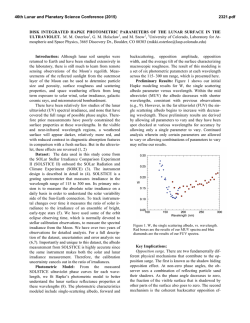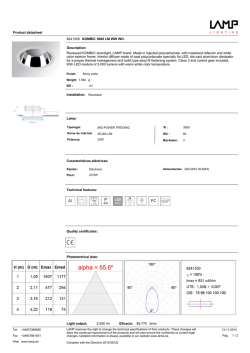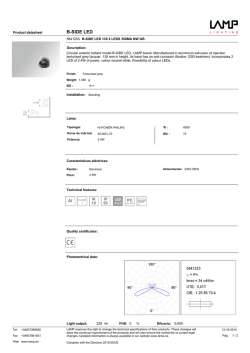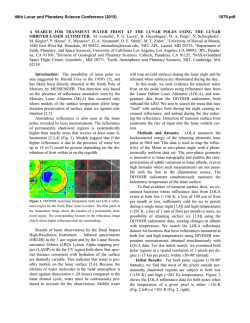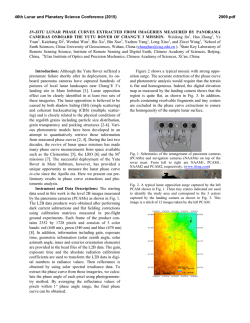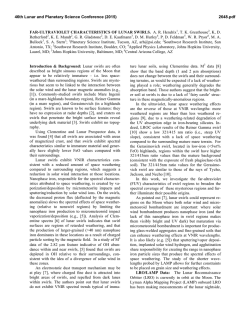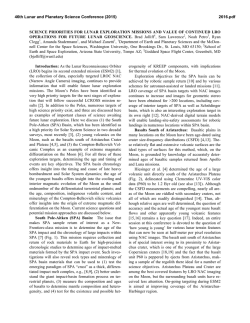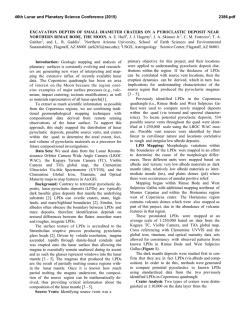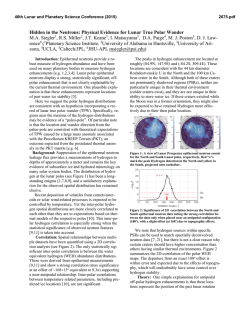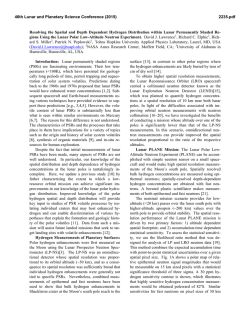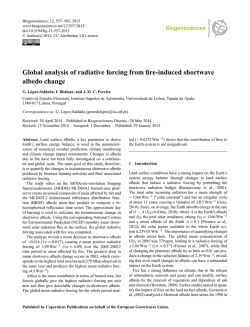
The Far-UV Albedo of the Moon as a Probe of the Lunar Cryosphere
46th Lunar and Planetary Science Conference (2015) 2213.pdf The Far-UV Albedo of the Moon as a Probe of the Lunar Cryosphere: LRO Lyman Alpha Mapping Project (LAMP) Latest Results. K. D. Retherford1, T. K. Greathouse1, G. R. Gladstone1, A. R. Hendrix2, K. E. Mandt1, A. F. Egan3, D. E. Kaufmann3, P. O. Hayne4, M. A. Bullock3, S. A. Stern3, J. Wm. Parker3, M. W. Davis1, D. M. Hurley5, W. R. Pryor6, P. D. Feldman7, C. Grava1, J. Mukherjee1, P. Mokashi1, C. M. Seifert1, C. J. Seifert1, and M. H. Versteeg1; 1Southwest Research Institute, San Antonio, TX ([email protected]), 2Space Sciences Institute, Tucson, AZ, 3Southwest Research Institute, Boulder, CO, 4Jet Propulsion Laboratory, Pasadena, CA, 5Johns Hopkins University Applied Physics Laboratory, Laurel, MD, 6Central Arizona University, Coolidge, AZ, 7Johns Hopkins University, Baltimore, MD. Abstract. Far ultraviolet (far-UV) albedo maps are obtained using the Lunar Reconnaissance Orbiter (LRO) Lyman Alpha Mapping Project (LAMP)’s innovative nightside observing technique [1]. Similar dayside FUV maps obtained using the more traditional photometry technique with the Sun as the illumination source are very complementary. LRO-LAMP measurements provide a unique perspective on the lunar "hydrological cycle," connecting the surface abundance of water frost trapped in the Moon's cryosphere to volatile transport processes involving the lunar exosphere. Introduction. The LRO-LAMP is a highly capable UV imaging spectrograph that addresses how water is formed on the Moon, transported through the lunar exosphere, and deposited in permanently shaded regions (PSRs)[2,3]. Importantly, the nightside imaging technique allows us to peer into the PSRs near the poles, and determine their UV albedos. LAMP data products include nightside and dayside brightness maps over specific wavelength ranges, and similarly constructed albedo maps (i.e., brightness maps normalized by the varying illumination). Lyman-α, on-band and off-band maps (i.e., on and off the water frost absorption band at ~165 nm) are useful for constraining the abundance of surficial water frost [1,4,5]. Key Results. Global nightside and dayside maps are now available, divided (at ±60° latitude) into polar and equatorial regions with stereographic and equirectangular projections, respectively. Additionally, new spectral image cube maps have been created for several regions of interest with 2 nm resolution. LAMP FUV albedo measurements indicate ~1-2% surface water frost areal-mixing abundances in a few PSRs based on spectral color comparisons, and we find that many PSRs may have porosities of ~0.7 based on relatively low albedos at Lyman-α [1,5]. The FUV albedo maps reveal lower albedo regions within the coldest PSR regions, determined with correlative analyses using LRO-Diviner maps [5]. Mandt et al., this meeting, will present updated analyses of the PSR reflectance measurements including a search for albedo changes on monthly timescales. Global dayside FUV albedo maps enable comparisons between the nightside and dayside photometry techniques to help validate the use of Lyman-α and starlight as illumination sources. Analysis of dayside spectra for selected regions complement the dayside maps, and are used to investigate space weathering and hydrated surface signatures [6]. A lab study of the FUV reflectance properties of Apollo samples, lunar simulants, and water ice is underway to further characterize the UV reflectance techniques. The far-UV spectral inversion property of the lunar albedo discovered by the Apollo 17 UVS is confirmed with the LAMP dataset [4], and Hendrix et al., this meeting, report that swirl regions show a UV-darkening, perhaps in response to changes in space weathering processes within these regions. Future Investigations. The LRO second extended science mission continues LAMP observations through September 2016. More surface reflectance data (60190 nm) at a variety of incident and emission angles will improve signal, spectral, and photometric quality and further develop our innovative nightside UV reflectance technique for identifying surficial water frost and determining surface porosity. Spectral image cube maps with 2 nm resolution are computationally expensive but are now being extended to cover all regions. LRO continues to target UV-interesting regions, including LROC imaging of key PSRs identified by LRO/LEND and Mini-RF as potentially water-rich. Global searches of water signatures outside of PSRs with LAMP confirm and elucidate the findings of surface water/hydroxyl and its variability with infrared Chandryaan-M3/Cassini-VIMS/EPOXI data [6], and future observations emphasize improved dayside coverage and trending of high-phase dawn/dusk regions. References [1] Gladstone, G. R. et al., Far-Ultraviolet Reflectance Properites of the Moon’s Permanently Shadowed Regions, J. Geophys. Res., 117, E00H04, 2012. [2] Gladstone, G. R., et al., LAMP: The Lyman Alpha Mapping Project on NASA’s Lunar Reconnaissance Orbiter Mission, Space Sci. Rev., 150, 161-181, 2010. [3] Gladstone, G. R. et al., LRO-LAMP Observations of the LCROSS Impact Plume, Science, 330, 472-476, 2010. [4] Retherford, K. D., et al., LRO/LAMP Far-UV Albedo Maps, in preparation, 2015. [5] Hayne, P. O. et al., Evidence for Exposed Water Ice in the Moon’s South Polar Regions from Lunar Reconnaissance Orbiter Ultraviolet Albedo and Temperature Measurements, submitted to Icarus, 2015. [6] Hendrix, A. R., et al., Lunar Albedo in the Far-UV: Indicator of Hydrated Materials and Space Weathering, J. Geophys. Res., 117, E12001, 2012.
© Copyright 2026

